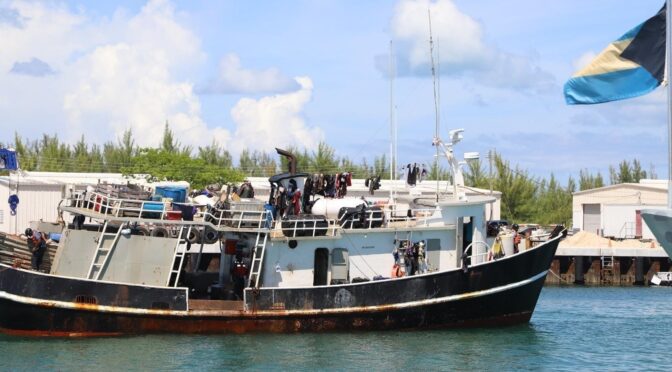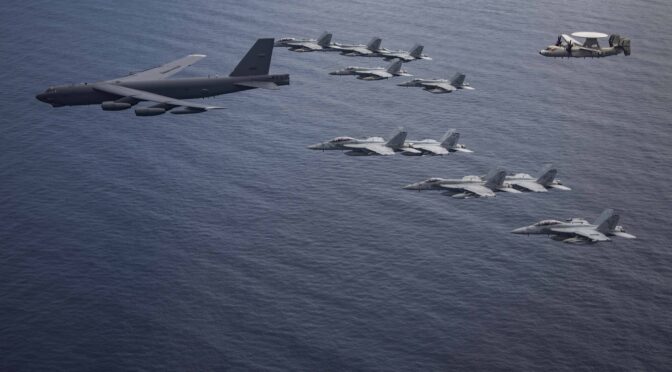By James Martin and Jasper Campbell
The U.S. Coast Guard has pivoted towards sustained operations in the Western Indo-Pacific Ocean. The Commandant of the Coast Guard, Adm. Karl Schultz, recently outlined significant plans for the region in several speeches and strategic documents.1 The strategy focuses on working with regional partner nations in an effort to “make the United States the partner nation of choice.” Adm. Shultz cites illegal, unreported, and unregulated (IUU) fishing as a chief concern, along with preserving the rules-based order.2 He notes that this paradigm shift, further articulated in the Coast Guard’s IUU Fishing Strategic Outlook, was “not intended to be a counter China Strategy…however China happens to be one of the biggest perpetrators of IUU fishing and IUU fishing is a global threat.”3 This pivot represents one of the most fundamental shifts in missions, one that places them directly in the same conversation as strategic competition.
On its face, the IUU Fishing Strategic Outlook necessitates sustained operations in the far reaches of the Western Pacific. However, in order to achieve the Commandant’s vision for becoming the partner of choice, the Coast Guard only need look 50 miles east of Florida to the Bahamas.4 The Bahamas is an archipelagic nation beleaguered by competing fisheries claims, including some coming from U.S. commercial and recreational fishermen. It presents a ready-made test bed for partner building and enforcing fisheries violations without the tyranny of distance. It has the further benefit of strengthening partnerships with the nation that enjoys the closest maritime boundary to the United States outside of Mexico and Canada, and where Chinese economic influence is finding a foothold.5 It is an environment where small U.S. Coast Guard cutters or “patrol boats” are uniquely suited to sustained law enforcement operations in shallow littorals.
The Problem
The Bahamas is comprised of over 600 banks and cays, stretching some 100,000 square miles.6 Its porous and remote maritime borders are a significant challenge for law enforcement, perhaps the most ready illustration of which is the rampant illegal fishing on the southern edge of the Bahamas by Dominican Republic fishermen.6 Dominican fishermen deploy from large, 150-175-foot long motherships in small dinghies and dive using homemade air compressors to harvest as much lobster, conch, and grouper and snapper species as possible. It is estimated that these illegal poaching ventures return to port with over 70,000 pounds of ill-gotten seafood in a single trip, and that they account for 35% of the known Bahamian lobster export of 12.5 million lobsters per year.7
As many as 65 other foreign countries have commercial fishing fleets that use Dominican ports as a starting point for illegal incursions into Bahamian waters.6 Illegal fishing ventures are often a nexus for other illicit activities, such as human smuggling and narcotics trafficking. In addition to the obvious deleterious economic impacts, IUU fishing precipitates second order economic effects, such as deterring tourism in the southern Bahamas from recreational boaters and anglers who are eager to avoid association with illegal activity.7 Meanwhile, farther north, a different illegal fishing threat starves the Bahamian economy. The Florida Fish and Wildlife commission estimates that as many as 50 recreational boats per day cross the Florida Straits to the Bahamas.8 Many are well within their rights to catch fish in Bahamian waters and transit back to Florida, provided they have cleared Bahamian customs and abide by specific regulations on how the catch is kept.8 Unfortunately, while most boaters maintain the correct permits and clear customs, in effect, paying the Bahamians their due for harvesting their natural resources, a great many do not.
It is well known in South Florida boating circles that South Florida-based commercial and recreational fishermen shoot across the Florida Straits to remote portions of the Great Bahama Bank, south of Bimini, to fill their coolers. While this perfidy is well known by word of mouth, no official studies on the scope of the problem exist. Consequently, enforcement mechanisms are left wanting. Occasionally, a returning fisherman may run afoul of a Coast Guard cutter on patrol, but most boaters make the 50-70-mile trip completely undetected by Bahamian or U.S. law enforcement. Because of the flagrant violations in the Southern Bahamas, “white collar” fisheries violations in the Northern Bahamas from U.S. citizens go largely unpoliced. With a surface force of merely eleven ships and a workforce operating at one-third capacity due to COVID-19, the Royal Bahamian Defense Force (RBDF) cannot adequately enforce the competing IUU fishing fronts.7,9 Along with debilitating natural disasters, such as Hurricane Dorian in 2018, IUU fishing undermines Bahamian maritime sovereignty and compounds economic fragility.
Becoming the Partner of Choice
While the Coast Guard’s IUU Fishing Strategic Outlook is global in nature, the constructs it will need to employ in order to achieve success have not been tested on a global scale. Capital assets such as the National Security Cutters (NSC) and soon-to-be active Offshore Patrol Cutter (OPC) possess the endurance and crew capacity to support multi-month deployments across affected regions. However, much of the effort required to address IUU fishing will invariably fall on small, capable patrol assets due to the shallow littoral environments that characterize the fishing grounds of the Western Pacific and Oceania. These environments cannot facilitate the same robust logistics chains on which the Coast Guard relies to sustain and maintain cutters in the United States or at its more remote facilities in Bahrain or Guam. Sustained IUU enforcement operations in regions like the Western Pacific require nimble assets such as the Coast Guard’s Fast Response Cutter (FRC) to traverse dense transit and fishing regions. These expeditionary style deployments will likely require refueling and resupplying in under-supported local ports for several months at a time, which can be extremely taxing for both crew and cutter.10
Within this context, it stands to reason that the Coast Guard should look to regional opportunities like the Bahamas to develop the familiarity necessary to adequately support these operations in distant waters. Bahamian waters are ideal for testing the operational schemas on which the Coast Guard will rely to affect successful IUU enforcement operations globally. The first step towards affecting this outcome is to establish a legal framework to allow Coast Guard cutters persistent access to Bahamian waters. A ready framework for this might be the existing Operation Bahamas Turks and Caicos (OPBAT), a multi-agency framework spearheaded by the U.S. Coast Guard that allows Coast Guard aviation assets and other Department of Homeland Security agencies to assist with counter-narcotics, migrant interdictions, and Search and Rescue missions in the Bahamas.11 U.S. Coast Guard cutters would ideally be paired with RBDF ship riders, imbuing them with Bahamian law enforcement authorities. With such authorities, U.S. cutters would be able to conduct routine patrols deep into Bahamian waters to execute IUU fishing enforcement operations. The interception of a September 2020 illegal fishing venture by the Coast Guard and RBDF venture is cause for celebration.12 Despite this success, joint enforcement efforts are sporadic at best. In order to effectively prosecute the IUU fisheries mission, efforts must be sustained and repeatable.
Fortunately, Coast Guard District Seven, encompassing the Southeastern United States, is home to 18, soon-to-be 20 Fast Response Cutters by 2022.13 With 64 planned FRCs, if the IUU fishing demand signal in the Bahamas indicates more are needed, more could be allocated to District Seven. A wealth of assets and short transits will be a boon to addressing illegal activities in the Bahamas and will build the necessary service “muscle memory” for counter IUU operations in archipelagic zones reminiscent of Pacific Island nations. Key Florida Coast Guard hubs in Miami and Key West are a short transit away and could serve as critical risk mitigators, allowing the Coast Guard flexibility to facilitate sustainment deep into Bahamian waters. ‘1.0 Coverage,’ similar to the Coast Guard’s congressional mandate for a high-endurance cutter to be retained in the Bering Sea at all times, could provide a similar force laydown model.14 It would provide enough operational flexibility to identify knowledge gaps and develop tactics in countering the IUU scourge.
This concept of operations can be implemented immediately; the assets necessary are in place and nothing needs to be procured. The only necessary action item is reaching a memorandum of understanding with the Bahamian government to allow cutters access to their territorial waters. There are, of course, objectors to the Coast Guard’s presence in the Western Indo-Pacific, whether because of imperialist optics or the notion that the Coast Guard should focus on guarding U.S. coasts instead of worrying about other nation’s problems.15 However, at a fundamental level, shoring up the maritime sovereignty of Western Indo-Pacific nations only strengthens U.S. national security in the region. If predatory distance water fleets are allowed to make wanton incursions into territorial waters to harvest a country’s natural resources, it undermines their sovereignty and exacerbates food insecurity. Further, it normalizes illegal behavior.
This same thinking applies to the Bahamas. By helping Bahamians shore up their maritime sovereignty with IUU fishing initiatives spearheaded by the Coast Guard, the United States will have a stabilizing effect on the Bahamian economy and security. Due to the persistent presence counter IUU operations require, they will have second order effects in deterring other illegal activities that the Coast Guard has expertise in prosecuting, such as counter narcotics trafficking and human smuggling. The United States has a vested interest in discouraging these illegal activities before they are able to proliferate through the perforated banks and cays that comprise the Bahamas. These illegal ventures make their way to the Western Bahamas, where detection windows are drastically reduced; only a 50-70 mile run across the Florida straits separates the United States from the Bahamas. The third order effects of “harvesting an easy win” in the Bahamas is that it infuses Coast Guard activities in the Western Indo-Pacific with legitimacy, bolstered by obvious and replicable success close to home.
Conclusion
With the specter of strategic competition, the mandate of the Coast Guard’s IUU Fishing Strategic Outlook requires expertise not only in the distant waters of the Western Indo-Pacific but also much closer to home in the Caribbean basin. In the Bahamas, the U.S. Coast Guard can establish a proof of concept in executing counter IUU operations without contending with the tyranny of distance or a lack of assets. This approach will deter illegal maritime activity in a nation that shares a porous maritime border with the United States, shoring up Bahamian maritime sovereignty while bolstering U.S. national security. If the Coast Guard spearheads a counter IUU fishing initiative in the Bahamas, competitors and allies alike will soon be put on notice that the Coast Guard has mastered expeditionary IUU fisheries enforcement.
Lieutenant James Martin is a Coast Guard Cutterman who has served aboard three Coast Guard cutters, including as commanding officer of the USCGC Ibis (WPB-87338). He holds a bachelor’s degree with honors in naval architecture and marine engineering from the U.S. Coast Guard Academy.
Lieutenant Jasper Campbell served on active duty for six years in the afloat and C5Icommunities. He is currently on a sabbatical, launching a technology startup, and hopes to return to sea in 2023 upon resuming active duty. He holds a bachelor’s degree in electrical engineering from the U.S. Coast Guard Academy.
References
2. https://www.uscg.mil/Portals/0/Images/iuu/IUU_Strategic_Outlook_2020_FINAL.pdf
4. https://warontherocks.com/2021/10/the-bahamas-a-close-but-unfamiliar-u-s-partner/
5. https://scholarship.law.duke.edu/delpf/vol28/iss2/5/
6. http://rbdf.gov.bs/wp-content/uploads/2021/02/Maritime-Security-Plan-2021.pdf
7. https://ideas.ted.com/an-encounter-with-poachers-in-the-bahamas/
8.https://myfwc.com/fishing/saltwater/recreational/bahamas/
9. https://www.damen.com/en/news/2013/04/patrol_vessels_for_royal_bahamas_defence_force
10. https://content.govdelivery.com/accounts/USDHSCG/bulletins/2a93090
11. https://www.dea.gov/press-releases/2015/09/09/opbat-assists-25-million-drug-bust-bahamas
12. https://www.atlanticarea.uscg.mil/Our-Organization/District-7/Units/
14. https://blog.usni.org/posts/2020/09/21/the-u-s-coast-guard-should-guard-the-u-s-coasts
Featured image: the U.S. Coast Guard and Royal Bahamas Defence Force crew interdict two Dominican Republic-flagged ships illegally fishing off Diamond Point, Great Bahama Bank, September 17, 2020. (Credit: Royal Bahamas Defence Forces)



